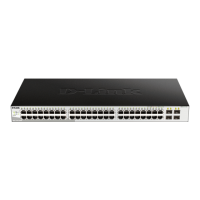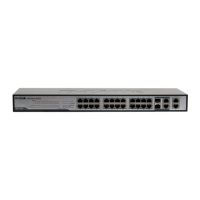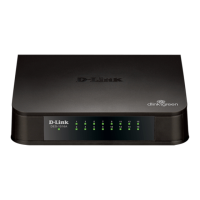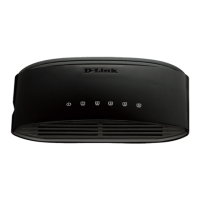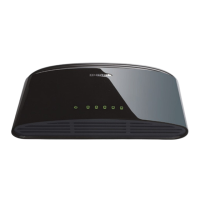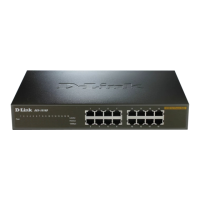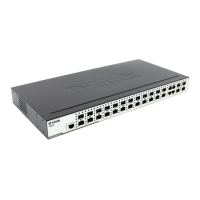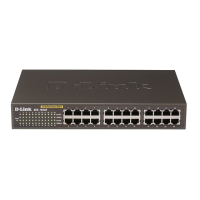Do you have a question about the D-Link DES-1210-28/ME and is the answer not in the manual?
Steps and commands to configure the switch's IP address for network management.
Allows creation of administrator, operator, or user accounts with usernames and optional passwords.
Enables the HTTP-based management software on the switch, allowing configuration via a web browser.
Restarts the switch, affecting only the individual unit if part of a stack.
Restores the switch to factory default settings, with options for config, system, account, or password.
Configures Ethernet port settings such as medium type, MDI/MDIX, description, flow control, speed, and state.
Configures L3 control packet prevention against DoS attacks, specifying type, action, and state.
Creates a new SNMP user and associates them with an SNMP group, specifying version and authentication.
Enables SNMP support on the switch, allowing monitoring and control via SNMP managers.
Creates a trusted host entry, allowing specific IP addresses to manage the switch via in-band management.
Checks copper cables for errors and determines their location, providing test results and fault distance.
Configures broadcast, multicast, and unknown unicast traffic control on ports, specifying action, threshold, and interval.
Configures traffic scheduling for QoS queues, specifying weights for hardware priority queues.
Configures bandwidth control on the switch, setting ingress (rx_rate) and egress (tx_rate) limits.
Configures network alarms, specifying alarm index, OID, interval, thresholds, and events.
Enables the port mirroring configuration, allowing traffic from source ports to be sent to a target port.
Creates a VLAN on the switch, specifying name, tag ID, or 1q VLAN advertisement.
Enables the Q-in-Q mode, allowing for 802.1Q VLAN tagging and translation.
Creates a link aggregation group with a unique ID and specifies the type (LACP or static).
Configures the System IP interface, supporting DHCP or static IP address assignment and gateway settings.
Configures BPDU attack protection state and mode (drop, block, shutdown) for specific ports.
Globally enables BPDU attack protection on the switch; cannot be used if STP is enabled on a port.
Enables the 802.1x Port-based Network Access control server application on the switch.
Configures port security settings, including admin state, max learning addresses, and address lock mode.
Enables SNTP server support, allowing the switch to synchronize time with SNTP servers.
Enables the SSH server on the switch, providing secure remote access.
Creates an access profile by examining packet headers (Ethernet, IP) for filtering or forwarding rules.
Steps and commands to configure the switch's IP address for network management.
Allows creation of administrator, operator, or user accounts with usernames and optional passwords.
Enables the HTTP-based management software on the switch, allowing configuration via a web browser.
Restarts the switch, affecting only the individual unit if part of a stack.
Restores the switch to factory default settings, with options for config, system, account, or password.
Configures Ethernet port settings such as medium type, MDI/MDIX, description, flow control, speed, and state.
Configures L3 control packet prevention against DoS attacks, specifying type, action, and state.
Creates a new SNMP user and associates them with an SNMP group, specifying version and authentication.
Enables SNMP support on the switch, allowing monitoring and control via SNMP managers.
Creates a trusted host entry, allowing specific IP addresses to manage the switch via in-band management.
Checks copper cables for errors and determines their location, providing test results and fault distance.
Configures broadcast, multicast, and unknown unicast traffic control on ports, specifying action, threshold, and interval.
Configures traffic scheduling for QoS queues, specifying weights for hardware priority queues.
Configures bandwidth control on the switch, setting ingress (rx_rate) and egress (tx_rate) limits.
Configures network alarms, specifying alarm index, OID, interval, thresholds, and events.
Enables the port mirroring configuration, allowing traffic from source ports to be sent to a target port.
Creates a VLAN on the switch, specifying name, tag ID, or 1q VLAN advertisement.
Enables the Q-in-Q mode, allowing for 802.1Q VLAN tagging and translation.
Creates a link aggregation group with a unique ID and specifies the type (LACP or static).
Configures the System IP interface, supporting DHCP or static IP address assignment and gateway settings.
Configures BPDU attack protection state and mode (drop, block, shutdown) for specific ports.
Globally enables BPDU attack protection on the switch; cannot be used if STP is enabled on a port.
Enables the 802.1x Port-based Network Access control server application on the switch.
Configures port security settings, including admin state, max learning addresses, and address lock mode.
Enables SNTP server support, allowing the switch to synchronize time with SNTP servers.
Enables the SSH server on the switch, providing secure remote access.
Creates an access profile by examining packet headers (Ethernet, IP) for filtering or forwarding rules.
| Brand | D-Link |
|---|---|
| Model | DES-1210-28/ME |
| Category | Network Router |
| Language | English |
